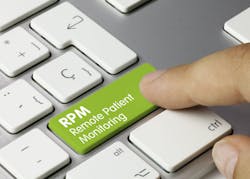The percentage of patients using remote monitoring technology is relatively low, but rapidly increasing. Stakeholders recently gathered to discuss recommendations in a new report from the Bipartisan Policy Center touching on evidence-based clinical guidelines, billing, and privacy issues.
Julie Harris, associate director of health policy at the Bipartisan Policy Center, led off a Jan. 25 webinar on the topic. She noted that Medicare, most state Medicaid agencies and many private health insurance plans cover services such as remote blood pressure monitoring. She said that just this month, the American Medical Association proposed a significant revision to remote monitoring billing codes.
Harris noted that in creating its report, the BPC engaged with a diverse group of stakeholders including policy experts, federal officials, medical providers, and payers.
She said that remote patient monitoring has the potential to transform disease management, especially for patients with serious uncontrolled conditions. It could also expand healthcare access for underserved populations, including those facing mobility challenges and rural residents. “But right now, access to remote monitoring is often based on where a person lives and who their provider is, rather than which patients stand to clinically benefit,” she added. “Some experts worry that we don't have sufficient clinical guidelines to inform how to best use these services, such as for which patients and for how long. Without these guidelines, we risk either underutilizing these services and denying patients care or over-utilizing them, leading to unnecessary spending. Now is the time for payers and providers to optimize the use of these emerging technologies.”
The sets of recommendations in the BPC report fall into three major categories.
The first set focuses on service coverage, where BPC calls for clear clinical guidelines on who should use these services and for how long, more flexible billing options for medical providers, and an expansion of remote therapeutic monitoring codes to include a broader range of conditions.
The report says that “as more evidence emerges about the appropriate use of remote monitoring devices, the secretary of HHS should use the department’s existing authority to recommend a diverse set of billing codes so providers have more options for the time they spend on the data and the number of minimum days of data required.”
The second set of recommendations focuses on ensuring high-quality and equitable use of remote monitoring services. BPC recommends policies to enhance access for underserved populations and require device labels to include information on performance across demographic groups.
The final set of recommendations focuses on patient privacy and security. BPC calls on the HHS Office of Civil Rights to communicate whether there are gaps in privacy protections, and if so either fix them or call on Congress to do so.
Current remote monitoring billing codes that require healthcare providers to gather data for 60 days, and then spend 20 minutes talking with a patient each month. During the webinar, Devin Mann, M.D., senior director of informatics innovation at NYU Langone Health, was asked how these requirements affect clinical care and whether he would like to see changes in them.
“I think they do have an impact, particularly in places where billing is still really important for keeping the operations running,” Mann responded.
“When I talk to my colleagues across the country leading other programs, most of us are not really doing much reimbursement. We're not billing all that much for this service, because we're still figuring it out,” he added. "We’re trying to understand how to really deploy it and make it work for everyone, and the reality is reimbursement is kind of low and and relatively onerous compared to other things. When you have a situation where it's kind of hard to do the billing, it doesn't bring in that much revenue and the clinical services are still being figured out, it’s not a very active area on the billing side. So if we made it a bit less onerous to do the billing, I think that would be an improvement. We'd have to find the right balance of reimbursement versus value.”
Ateev Mehrotra, M.D., M.P.H., a professor of healthcare policy and medicine at Harvard Medical School and a hospitalist at Beth Israel Deaconess Medical Center, said we are seeing remote patient monitoring being underutilized and we want to target it to those patients who have uncontrolled illness or really high-risk situations. “But we're also seeing remote patient monitoring being used for patients who are doing really well with their chronic illness. And not surprisingly, if you're doing pretty well, adding this on top of that is not going to be beneficial.”
Mehrotra said the billing situation is contributing to the low-value use we are seeing. “That's because the current billing system encourages a clinician to do it for as many patients as possible because it takes so much investment to build the infrastructure, and after that, you're going to try to get as many patients on it as possible. So I am overall supportive of the idea of more targeted use of it, but that's going to require some increased reimbursement, from my perspective, for those patients who use it because you need to maintain this infrastructure.”


